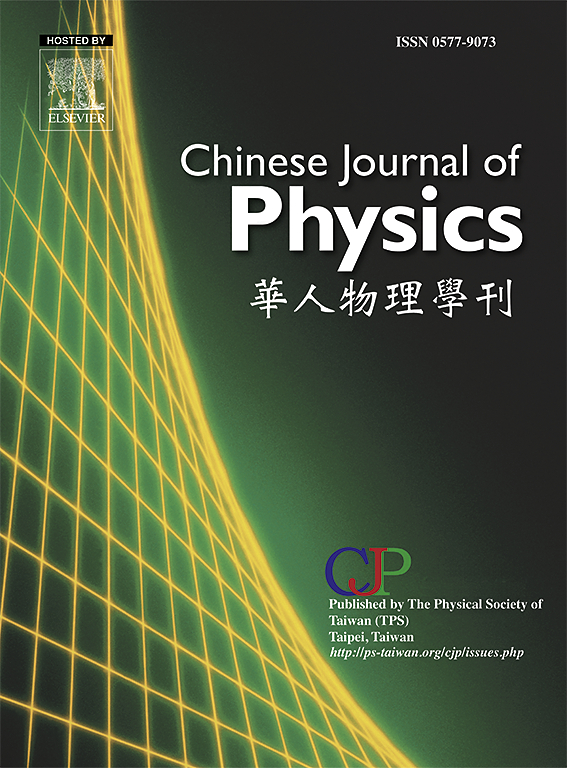Investigating the thermal dynamics of two-layered immiscible fluids in corrugated curved channel with applied heat source
IF 4.6
2区 物理与天体物理
Q1 PHYSICS, MULTIDISCIPLINARY
引用次数: 0
Abstract
The corrugated curved channels (CCs) in heat exchangers can enhance the heat transfer where two immiscible fluids are used, by promoting interfacial areas. The results of this study may inspire creative designs for thermal management systems, which could result in the creation of new applications and technology. The corrugations improve the energy collection and conversion efficiency. In solar thermal collectors, a heat source in corrugated curved channels is used to improve solar energy absorption to transfer it to a working fluid. On the other hand, the heat sinks are used to remove the heat that is not needed during the chemical separation processes. With this motivation, the main aim of this study is to analyze the heat transfer enhancement in two-layered immiscible viscous fluids (VFs) flow by using the heat source/sink phenomenon. The curved channel is divided into two regions. Both regions are occupied with VFs having different viscosities. The flow is caused by a constant pressure gradient. The analytical expressions for velocity and temperature are obtained through the perturbation series method (in terms of small corrugation amplitude ) by solving the mathematical model of partial differential equations. The effect of different parameters on fluid and heat flow is analyzed through graphs and contours. Moreover, the shear stresses (SS) at the walls of CC with corrugated boundaries, rate of heat transport and volume flow rate (VFR) are also analyzed and discussed. The results show that the heat is more enhanced when a heat source is provided to the system whereas a heat sink causes a fall in heat through the immiscible VFs flow. So, to enhance the heat when necessary, a heat source can be used in corrugated CC. Furthermore, SS is decreased when the wavenumber is increased. The wavenumber implies a small corrugation wavelength which leads to a more undulating path. For this type of path, a larger amount of SS is needed for fluid to flow at walls.

应用热源研究了波纹弯曲通道中两层非混相流体的热动力学
在使用两种不混相流体时,换热器中的波纹弯曲通道(CCs)可以通过扩大界面面积来增强传热。这项研究的结果可能会激发热管理系统的创造性设计,这可能会导致新的应用和技术的创造。波纹提高了能量收集和转换效率。在太阳能集热器中,采用波纹弯曲通道中的热源来提高太阳能的吸收,将其转移到工作流体中。另一方面,散热器用于去除化学分离过程中不需要的热量。基于这一动机,本研究的主要目的是利用热源/汇现象分析两层非混相粘性流体(VFs)流动中的传热强化。弯曲的河道分为两个区域。两个区域都被不同粘度的VFs所占据。流动是由恒定的压力梯度引起的。通过求解偏微分方程的数学模型,采用微扰级数法(以小波纹幅度ε≪1表示)得到了速度和温度的解析表达式。通过图形和等高线分析了不同参数对流体和热流的影响。此外,还对具有波纹边界的CC壁面剪应力、传热率和体积流率进行了分析和讨论。结果表明,当系统中有热源时,热量得到了更大的增强,而散热器通过不混相的VFs流引起热量的下降。因此,为了在必要时增强热量,可以在波纹CC中使用热源,并且随着波数的增加,SS降低。波数意味着一个小的波纹波长,这导致了一个更起伏的路径。对于这种类型的路径,流体在壁上流动需要更大的SS量。
本文章由计算机程序翻译,如有差异,请以英文原文为准。
求助全文
约1分钟内获得全文
求助全文
来源期刊

Chinese Journal of Physics
物理-物理:综合
CiteScore
8.50
自引率
10.00%
发文量
361
审稿时长
44 days
期刊介绍:
The Chinese Journal of Physics publishes important advances in various branches in physics, including statistical and biophysical physics, condensed matter physics, atomic/molecular physics, optics, particle physics and nuclear physics.
The editors welcome manuscripts on:
-General Physics: Statistical and Quantum Mechanics, etc.-
Gravitation and Astrophysics-
Elementary Particles and Fields-
Nuclear Physics-
Atomic, Molecular, and Optical Physics-
Quantum Information and Quantum Computation-
Fluid Dynamics, Nonlinear Dynamics, Chaos, and Complex Networks-
Plasma and Beam Physics-
Condensed Matter: Structure, etc.-
Condensed Matter: Electronic Properties, etc.-
Polymer, Soft Matter, Biological, and Interdisciplinary Physics.
CJP publishes regular research papers, feature articles and review papers.
 求助内容:
求助内容: 应助结果提醒方式:
应助结果提醒方式:


